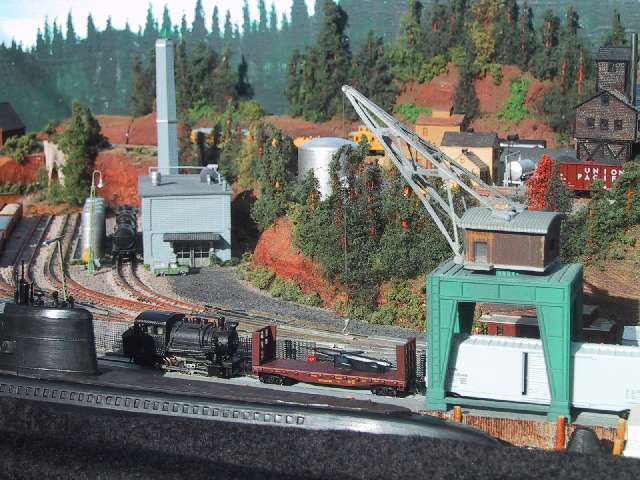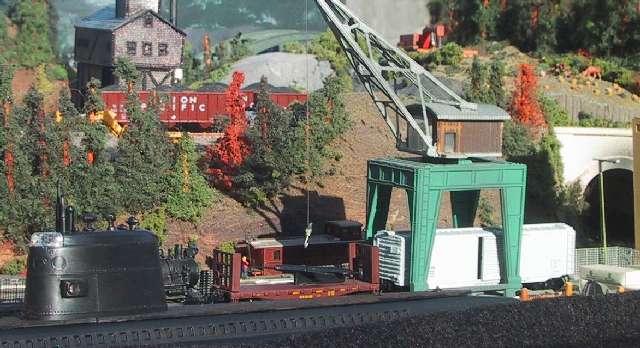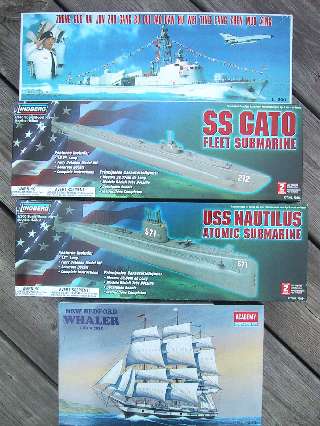The Val Ease Central Railroad ©
Taking Z Scale to the Public Around the World
(Text and photos © Copyright Jeffrey MacHan)
Last Spike: A Stealthy Visitor to Val Ease Port Authority

A secret cargo for a secret mission? SSN 571 Nautilus' stealthy visit to Val Ease does not go unobserved!
Wait a minute! It appears that one of the members of our submarine fleet has made an unannounced stop at the wharf of Val Ease Port Authority. Only a few hands are on deck at the moment but it is difficult to make out what they are doing. A couple of what appear to be Marines are on the quay and seem to be waiting for something.
The conning tower is unlike any sub I'm familiar with. I can't make out the designation. In fact, I don't see any markings at all. Guards have now taken up position at all entry points to the dock area.
Wait, there are a couple of freight cars being moved along side the sub. It appears that the submarine is taking on cargo of some kind. I'll try to move a little closer to see...hey! what are you guy's doing here? Don't point that at me! Let go, you can't do...." STATIC
Setting the scene:
As you may recall, the original occupants of the VEPA wharf included a tug and barge. Most layout scenes are static but with a little foresight it is possible to do more in the same space. The secret supply stop by the mysteriously unnumbered submarine at VEPA demonstrates how a harbor area can host several settings as ships arrive and depart.
When I began looking for vessels to make berth at VEPA, I did what any hobbyist might do. I scoured the local hobby shops for ship models that were in the 1:220 scale range. The search was fruitless for the most part until I came across a 1:200 Chinese missile frigate made by Lee (N0. 02701). The hull is a perfect fit for the 12" dock and would make a very impressive Veterans Day visitor except that it is by far too modern for the VEC's 1954 time frame.
My next "find" was a 1:240 scale model of the SS 221 Gato (Lindberg kit no. 70885). SS 221 is a W.W.II diesel-electric fleet submarine of the US Navy. The hull measures 15", three inches too long for VEPA but shortening the hull remained an option although it would require some tricky cutting, filling and sanding. I kept looking until, finally, I discovered the USS Nautilus (Lindberg kit no. 70884) hidden under a dusty pile of boxes at some obscure hobby store. The price was right so it joined my slowly growing near-Z fleet. Now it was time to do some background research on the web to find the "perfect" vessel to tie up at VEPA.

Mike Ruffone ran into more than just deer grazing on the slopes of Vista Ridge!
The Nautilus is a 1:300 scale model that fits perfectly in the 12 inch long wharf. It is also a skill level 2 kit, perfect for yours truly. The only hard part of the model-building stage of this project was to cut the hull along the water line in something akin to a straight line. Fortunately, the ship has molded on ridges running the length of the hull that help guide a deep-bladed razor saw held between trembling fingers. It only took about five minutes to perform the surgery and to file the edges flat in some spots. Since the visitor was on an obvious secret mission, I deemed it unnecessary to apply the decals that were supplied with the kit. 571 would stand out in 20 foot high numbers for later, more public voyages.
My original plan was to have 40 sailors standing in parade formation on the deck of the boat. It would have been relatively easy to populate the scene with Preiser figures from a 160 pack (stock number 8500). They come out of the box in clean white which would simplified any painting chores. But that wouldn't be much in keeping with the surreptitious nature of the stealthy visit to VEPA, would it?
The scene is completed with the delivery of the secret cargo in the Micro-Trains Line 50' Navy box car and UP bulk-end flat being gingerly positioned by the VEPA #2, a Marklin 0-6-0 with a super-detailed ISM Alco shell and Micro-Trains Line 902 couplers. If one looks closely, the flat seems to be carrying a missile. One can only wonder what that Navy boxcar contains...warheads, perhaps? Still, I wouldn't ask too many questions around those MPs!
Oh, in case you were curious, SSN 571 was commissioned September 30, 1954 as America's first nuclear powered submarine. Officially, she entered regular duty in 1955 but who knows what ports-of-call she might have made... before cruising under the North polar ice cap. USS Nautilus is a now part of the US Navy Submarine Force Museum, located on the Thames River in Groton, Connecticut. See Nautilus web site for more information on this historic ship.
Try a little imaginative "historical" scene switching on your layout or module. It's fun, it's easy and you may discover a whole new 'story' to tell!
P.S. I can still use those forty sailors in parade whites when my newest addition to the VEC "fleet" makes an "official" stop at VEPA. On a very recent whirlwind hobby shop tour with a visiting Z-nut from France, I stumbled across an extraordinary find...a three-masted bark! The 1/200 scale "New Bedford Whaler, circa 1835", kit number 14441 from Academy Hobby Model Kits measures 5" long at the waterline and will make an impressive and attractive visitor to VEPA for the next Val Ease County tall ships regatta. My only concern will be the reaction of the city fathers when 40 sea-weary and adventure-seeking sailors descend on Val Ease East for shore leave!

Hobby shop browsing has turned up 4 vessels that will make attractive visitors to VEPA.
Completing the concrete pad on CVE DockPreparing the concrete pad of Centre Val Ease dock took me 3 weeks of fiddling, testing, scrapping of materials and head scratching to finally come up with the solution...Cork roadbed! I needed a material that was resilient, and easily carved in order to simulate the poured concrete of a working river port. It also had to cover the ties of the siding that obviously had to run along the dock, over which an overhead dock crane would move. I started out with bass wood but it needed to be shimmed and I didnít like the surface, it looked too much like wood! A week passed... Then I tried styrene but I had problems cutting it to shape and I didnít want to have to use solvent based paints to paint it. A week passed... Finally since I had found solutions to the 100 or so other little problems that cropped up in other areas of the layout, I came back to the dock. I had a couple of left over pieces of cork which I off handedly tried to fit along side the dock track lead. Hey, what do you know? The height was perfect for the concrete pad. A week passed... Now what to do with the track lead? I cut its outline in the cork and took out the strip. As a result, the track would have a cute little down slope from the mainline switch into the dock compound. Even better! I then cut a very thin piece of cork and laid it along the edges of the ties. Bingo, they were gone and the transition to the pad was perfect. This looked promising so I took everything up, glued the cork in permanently, attached leads to the ends of the rails, painted the rails rusty black and glued the track down permanently. Then came the strips along the edges of the ties and finally, I placed my one piece of salvaged stripwood between the rails and test ran a car and loco along the siding. No problemo! Glued permanently. The next step was to paint the cork with a nice thick layer of neutral gray acrylic paint. It dried darker than out of the tube and penetrated the cork surface. It actually looked like concrete. Well close enough for both me and my wifeís tastes. Details were then added like a 10 foot high security fence with access gates, a guide rail for the traveling dock crane, a storage shed along the dock for maintenance personnel. I also installed aluminum siding along the dock and cut and glued pilings in place spaced about 1 inch apart. I prepared the river surface using a base coat of thick dark brown acrylic paint mixed with black and some white to create depth and eddies in the water. Once dry, I applied a thin first coat of acrylic gloss medium. Once that had dried I began to apply a series of 5 coats of medium, teasing the surface with a small brush to create waves in an irregular pattern to simulate the surface of a river waterway. Believe it or not, I managed to record a juvenile seagull squawking to its mother for food. Got my background sound effects! (Itís usefull to keep a voice recorder in your pocket for just such opportunities!) |